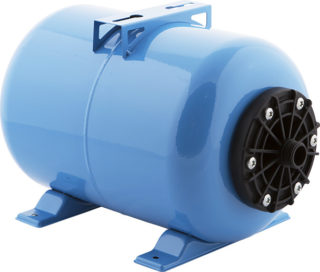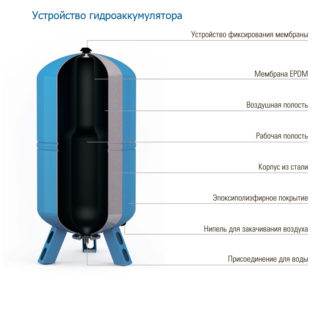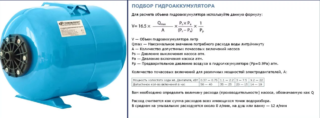In order for the water supply of a private house to function without interruption, it is important to select a suitable hydraulic accumulator - a metal or plastic container for connection to the pumping equipment of the water supply. The inner part of the tank is used to store a reserve volume of liquid under a certain pressure, which allows not to be left without water in case of power outages. But the device has other useful functions that must be taken into account when choosing it.
Purpose of the hydraulic accumulator

Structural elements of the hydraulic tank: body, connection nipple, polypropylene gasket and pear-shaped rubber diaphragm, which prevents water from contacting the inner surface of the body.
In addition to preserving the water reserve, the accumulator is also used for the following purposes:
- maintaining a stable pressure in the water supply system;
- reducing the frequency of starting and stopping pressure equipment;
- protection of the pump from wear;
- protection against water hammer.
The pressure unit equipped with a hydraulic accumulator saves more on energy and water consumption.
The diaphragm inside is hermetically connected to the body by means of a flange equipped with a threaded nipple for connection to the water supply system. The pressure is generated by the air between the walls of the device and the diaphragm.
Liquid from a well or well under a pressure of 1.5–2 atmospheres increases the volume of the membrane connected to the water supply system. As a result, the air is compressed, which leads to an even greater increase in pressure. When a certain level is reached, the relay stops the supply of electricity and the pump turns off. Further, as the reserve stock is spent, the relay records a decrease in pressure, starts the pumping equipment and the cycle repeats.
Types of accumulators
Hydraulic tanks, depending on the version of their installation, are vertical and horizontal. Structurally, they differ only in one thing: the first, with a volume of more than 50 liters, are equipped with a valve for bleeding air, which accumulates in the water compartment and reduces the efficiency of the device.
In horizontal accumulators with a volume of 50–100 liters, the valve is installed in the side end. Air from the water compartment in hydraulic tanks less than 50 liters is vented, completely draining the liquid.
The main criteria for choosing a device for a country house
The working pressure of the device must be set 0.1–0.5 atmospheres less than the indicator for automatic start-up of pumping equipment. For example, the pump turns on at 1.6 atmospheres. The accumulator pressure should be 1.3-1.5 atmospheres. This is the minimum indicator at which the hydraulic tank operates. It is also important to take into account the maximum pressure that is safe for the drive. Its value can reach 8-10 atmospheres.
Excessive overestimation of the pressure level in the hydraulic tanks can lead to breakdowns of mixers, household appliances, and the pump.The 1.5 atmosphere reading is based on numerous process tests.
Pay attention to the material from which the drives are made. It is better to choose tanks made of steel. They are more reliable, since the plastic case can deform. The diaphragm will protect the metal walls from rust. But steel devices are more difficult to install, as they weigh a lot.
The material of the "pear" differs in resistance to high or low temperatures, service life:
- Natural rubber rubber is quite elastic, but at the same time it has low resistance to water diffusion. It is used at temperatures from 0 to 50 degrees Celsius.
- Butyl artificial rubber is not as elastic, but with a long service life. Temperature range from 10 degrees below zero to 100 degrees Celsius.
- Artificial rubber made of ethylene-propylene surpasses the first types in quality and reliability.
If the manual for the hydraulic accumulator indicates that the diaphragm is made of food-grade EPDM rubber, its service life is long enough even with intensive use of the device. Temperature range from 50 degrees below zero and 130 degrees above zero.
It is necessary to take into account the design features of the membrane installation. It can be built-in and removable. The latter options have the advantage of changing the diaphragm very easily when the diaphragm breaks. The part is removed from the hydraulic accumulator through a flange mount on the tank neck. When carrying out repair work on a storage tank with a large internal volume, it is necessary to check in advance for the presence of additional fastening of the diaphragm on the side opposite to the flange.
Calculation of the required volume
- Unloading the pump. Due to the fact that it is recommended to run pressure devices no more than 30 times per hour, and in everyday life, as a rule, models with a capacity of up to 40 l / min are used, batteries with a volume of about 100 liters are suitable for home use. They solve the problems with the need to start pumping equipment frequently.
- Support of the required pressure. When the pump is not working, even a device with a tank volume of only 24 liters can create the required water pressure. These are usually purchased for small apartments with a standard number of water intake points. You can install the tank anywhere in the water supply system, but to improve efficiency, it should be mounted as close to the pump as possible.
- Creation of a safety stock. If there is a need for a backup source of water during a power outage, you should purchase stoliter models. The useful volume of the hydraulic tank is on average 40 percent of the declared one.
If a battery is required to compensate for water shortages during peak periods, special formulas are used to calculate the volume of the unit. They take into account the performance and power factor of pressure equipment, water flow, water and air pressure and other parameters. There are many options, and only a person who knows how to count can accurately determine the required indicator.
For example, you can apply the following equation:
O = K x R x (Dmax + 1) x (Dmin + 1) / (Dmax-Dmin) - (P + 1), where:
- K is the power factor of the pressure vessel;
- Rmax is the maximum planned flow rate in liters per minute;
- Dmax - the level of fluid pressure in the hydraulic tank to turn off the pumping device;
- Dmin - the lowest water pressure limit for starting the pump;
- P is the air pressure in the accumulator.
The last three values are taken in bars.
The peculiarity of the method is that even if you get a result of 38.5 or 42.7 liters, you will need to purchase a fifty-liter drive.
If a mistake was made in the calculations or the water consumption increased after installation, you can always install another hydraulic accumulator. They will act as one drive.
It is rational to purchase a hydraulic tank with a volume of more than 100 liters in case of frequent and prolonged interruptions in the power supply of the house, when a significant reserve of drinking water is required or with a high flow rate of liquid. Otherwise, the water will stagnate and lose its taste. However, small tanks practically do not provide protection against water hammer. These are more suitable for giving.
The 50-liter hydroaccumulator can be chosen for a family of 4. The optimal performance of the device should be approximately two cubic meters per hour.
Comparison of popular models
The quality of the battery you like can be checked by reading the responses of users on the Internet. In addition, it is preferable to buy well-known brands. Such firms will not risk their reputation and sell low-quality products. Based on the reviews, you can make a rating of popular models. It will allow you to compare technical indicators and choose the device that is right for you.
Rating of accumulators for water supply systems:
| Manufacturer | Model | Comparison of parameters | Owners opinion | ||||
| Capacity | Pressure | Temperature | Location | Price | |||
| Gilex | 50 GP | 50 l | 8 atm. | Maximum 99 degrees | Horizontal | RUB 3000 | Reliable and easy to maintain, replaceable diaphragms are not easy to find on the market. |
| Belamos | 24 SS | 24 l | 6 atm. | 45 degrees maximum | Horizontal | 3500 RUB | Great for a small private home. |
| Gilex | Poplar 100 VM | 100 l | 10 atm. | Maximum 99 degrees | Vertical | RUB 4500 | Good build, the pump turns on much less often. |
| Reflex | DE 100 HW | 100 l | 10 atm. | 70 degrees maximum | Vertical | RUB 13,000 | A high-quality German brand, but the membrane often breaks, and it is expensive to replace. |
| Wester | WAV 12 | 12 l | 10 atm. | Maximum 99 degrees | Vertical | 1200 RUB | Simple, inexpensive, it is worth checking for leaks before installation. |
A comparative review will help determine the characteristics of the desired tank, even if it is not on the list of popular models.
A hydraulic tank is necessary for the smooth operation of the water supply system, especially in a country house where a borehole pump is installed. The right choice will protect your equipment from wear and tear and always remain with a supply of water.










